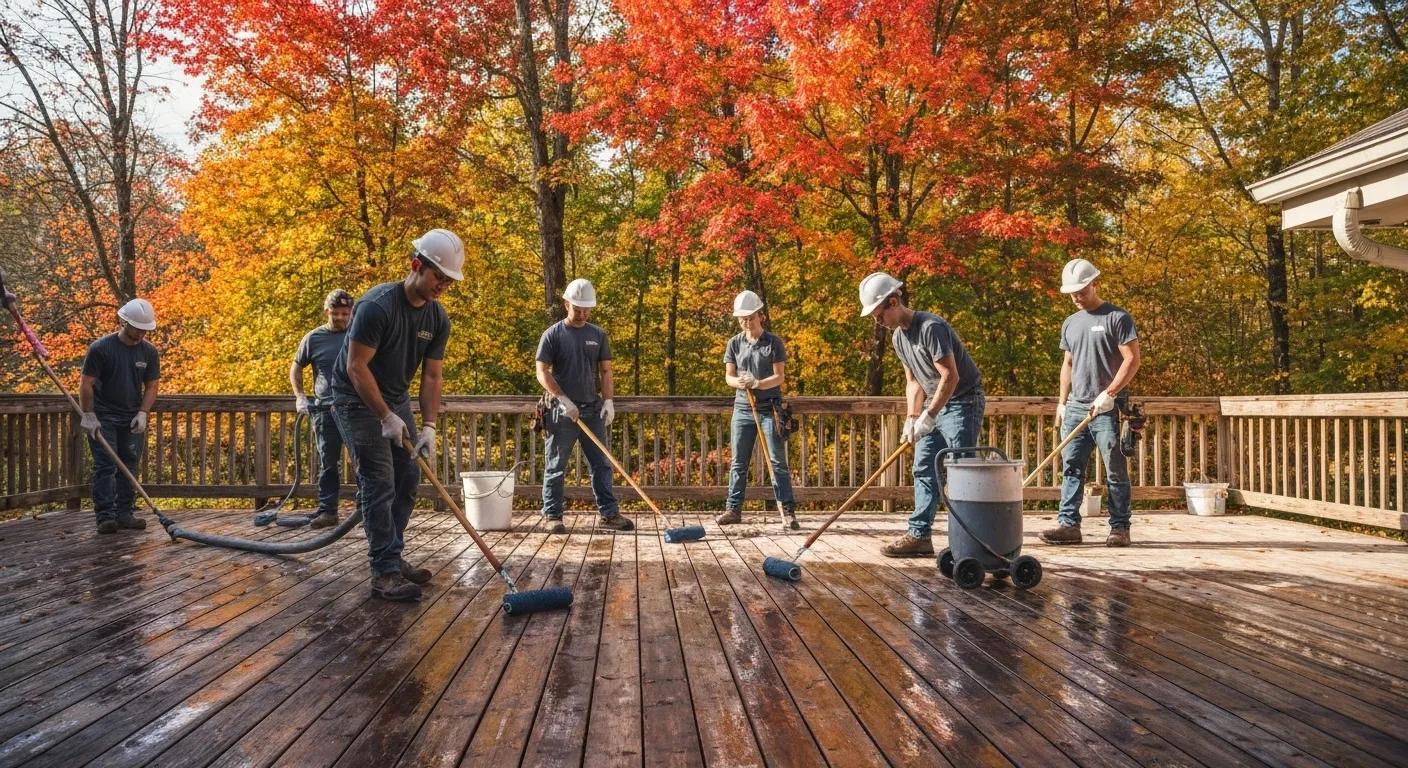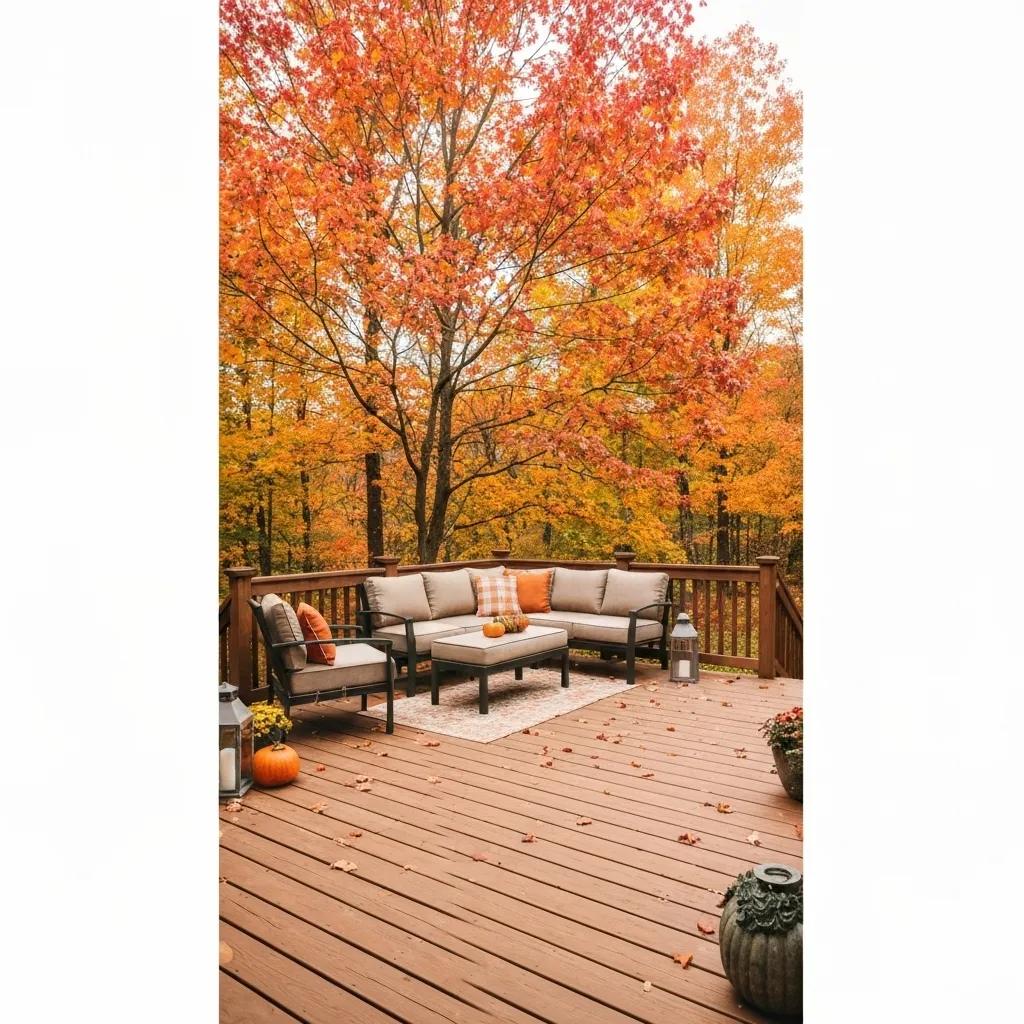Fall Deck Care & Winter Prep: Get Your Deck Ready Before You Know It’s Fall
As the air turns crisp and leaves begin to fall, it’s the perfect moment to shield your outdoor wood from winter’s chill. Addressing your deck’s fall maintenance now ensures it remains sturdy, dry, and attractive through the harsh Great Lakes winters. This guide will walk you through why fall is the prime time for deck upkeep, a detailed plan for cleaning, fixing, staining, and sealing, the advantages of professional winterization versus a DIY approach, and special tips for both wood and composite decks. You’ll also discover region-specific strategies for handling freeze-thaw cycles, heavy snow, and moisture, and finally, how to easily get a free, personalized quote from Timberseal.net.
Why Fall is the Prime Time for Deck Upkeep in the Great Lakes Area
Fall deck maintenance in the Great Lakes region involves the seasonal routine of cleaning, checking, and protecting your outdoor decking before winter sets in, preventing moisture damage and extending its life.
Mild days, typically between 50–70°F, and lower humidity create ideal conditions for stains to soak in and sealants to set properly, reducing the chance of cracks and rot when temperatures plummet below freezing.
For instance, applying a quality deck stain in early October can block water from seeping in, which would otherwise freeze within the wood’s fibers and cause warping by springtime.
These conditions pave the way for the next crucial step: understanding the unique challenges of our region.
What Unique Challenges Do Decks in the Great Lakes Face in Fall and Winter?
- Freeze-Thaw Cycles – Repeatedly freezing and thawing draws moisture into wood cells, then expanding ice crystals cause splintering.
- Snow Loads – Piled-up snow can weigh 20–30 lbs per square foot, putting stress on deck joists and fasteners.
- Lingering Moisture – Autumn rains and melting frost create persistent dampness that encourages wood rot and mold.
These stresses highlight the need for proactive fall maintenance to protect the deck’s structural soundness and prepare it for the next phase: targeted cleaning and inspection.
How Freeze-Thaw Cycles Impact Wood’s Strength
How Does Fall Deck Maintenance Ward Off Winter Damage and Extend Your Deck’s Life?
Regular fall upkeep clears away debris that promotes decay, strengthens loose connections, and seals surfaces, creating a barrier against moisture to stop ice from getting in. By pressure washing away mold and mildew, tightening nails and screws, and applying a protective deck stain, homeowners significantly reduce the risk of rot, splintering, and expensive repairs. This proactive approach can add up to five years to your deck’s lifespan compared to neglected wood, making annual fall maintenance a vital strategy for long-term preservation.
When is the Ideal Time to Stain and Seal Your Deck in the Fall?
The sweet spot for staining or sealing decks in the Great Lakes region is from mid-September through early October, when daytime temperatures consistently stay above 50°F and nighttime lows remain above 40°F. During this period, humidity typically drops below 60%, allowing oil– or water-based sealants to fully cure within 24–48 hours before any frost appears. Scheduling your staining tasks at least two weeks before the first expected freeze ensures your deck surface effectively locks out moisture, getting your outdoor space ready for winter.
Perfect Weather Conditions for Deck Staining
What Are the Key Steps for a Complete Fall Deck Maintenance Plan?

A thorough fall deck maintenance checklist covers cleaning, inspection, repairs, staining, and sealing to provide comprehensive winterization services. Following these four steps protects your investment, cuts down on future repair expenses, and keeps your home looking its best.
Step 1: How to Thoroughly Clean Your Deck and Remove Debris in the Fall?
Start by clearing away leaves, dirt, and pollen that trap moisture against the wood and can encourage mold growth.
- Use a leaf blower or a stiff broom to whisk away loose debris.
- Apply a gentle, biodegradable deck cleaner using a brush or a low-pressure washer to break down mildew and algae.
- Rinse with a pressure washer set between 1200–1500 psi, keeping the nozzle 12–18 inches from the surface to prevent damaging the wood fibers.
Completing this cleaning step reveals any hidden cracks or flaws and eliminates the moisture retention that speeds up wood rot, getting the deck ready for inspection.
The Impact of Moisture on Wood Decay
Step 2: What Should You Inspect and Repair on Your Deck Before Winter Arrives?
Examine every board, railing, and fastener for any signs of wear or damage to prevent safety issues and structural problems under heavy snow.
- Check deck boards for splinters, cracks, or soft spots that might indicate rot.
- Tighten or replace any loose nails, screws, and bolts to ensure stability.
- Inspect joists and connections to the house for signs of corrosion or separation.
- Repair or replace damaged railings and balusters to maintain safety standards.
Addressing these repairs now helps prevent costly winter damage and smoothly transitions into the protective finishing stage with stain and sealant.
Step 3: How to Select and Apply Deck Staining and Sealing for Winter Protection?
Choosing the right deck stain and sealant is key to locking out water and UV rays, preserving the wood’s color and integrity throughout the cold months.
Start by gently stirring the product, then apply two coats with a brush or roller, making sure to cover all the joints and end grains thoroughly. Applying it at the right time prevents moisture damage and extends your deck’s life, setting the stage for composite deck care if applicable.
Step 4: What Special Care Do Composite Decks Need for Fall and Winter?
Composite decking resists rot but still needs specific care to prevent staining and damage.
- Sweep or blow off debris weekly to stop organic matter from building up.
- Clean using a manufacturer-approved composite cleaner and a soft-bristle brush.
- Check seams and hidden fasteners for any signs of shifting or wear.
- Avoid using metal shovels; opt for plastic shovels or rubber-tipped pushers for snow removal.
Proper care for composite decks ensures that winterization efforts protect without harming the deck’s durable surface, leading us to compare professional versus DIY methods.
How Do Professional Deck Winterization Services Compare to DIY Fall Maintenance?

Professional fall deck maintenance services bring together expertise, specialized tools, and top-quality products to ensure consistent stain and sealant application, thorough structural repairs, and long-term warranty protection.
What Are the Advantages of Choosing Timberseal.net for Your Fall Deck Preparation?
- Our knowledge of the local climate ensures precise timing for stain and seal applications.
- Our high-performance coatings are more effective against mold, mildew, and freeze-thaw damage than standard consumer products.
- Our warranty coverage on labor and materials offers peace of mind and future security.
These benefits allow homeowners to enjoy a well-maintained deck without dedicating their own time or risking mistakes from improper techniques.
How Do Professionals Guarantee the Best Stain and Sealant Application in Fall?
Expert teams closely monitor temperature, humidity, and dew point to ensure coatings cure perfectly. By calibrating spray equipment and using techniques like back-rolling, professionals achieve even coverage and consistent film thickness, preventing blotchy color or peeling. This detailed approach delivers durable waterproofing that goes beyond typical DIY results.
What Repairs and Treatments Are Best Handled by Professionals Before Winter?
Complex structural issues and specialized treatments require professional expertise:
- Reinforcing Structural Joists – Adding sister joists or reinforcing ledger boards beneath the deck level.
- Addressing Deep Rot – Cutting out decayed wood and installing new, pressure-treated lumber.
- Installing Advanced Waterproofing Membranes – Setting up deck-under-deck systems to protect lower levels.
Entrusting these services to experienced technicians establishes a strong foundation for winterization that complements basic DIY upkeep.
What Are the Top Practices for Staining and Sealing Your Deck Before Winter?
Applying the right products under ideal conditions helps maintain color, waterproofing, and UV protection throughout winter and into spring.
Which Deck Stains and Sealants Provide the Best Winter Defense?
Oil-based stains penetrate deep into wood fibers, offering robust moisture resistance, while advanced water-based sealants create a surface shield that repels water and resists mildew. A combination of both can offer the benefits of deep penetration and quick drying.
How Do Temperature and Humidity Impact Deck Stain Application in the Fall?
Stain adheres best within a consistent temperature range of 50–85°F and relative humidity below 65%. Higher moisture levels slow down the curing process, resulting in sticky surfaces that attract dirt and encourage mold. Keeping an eye on weather forecasts helps with precise scheduling and ensures the stain’s integrity.
What Are the Advantages of UV Protection and Waterproofing in Fall Deck Sealants?
UV blockers protect wood pigments from sun-induced oxidation and fading, while waterproofing agents form a barrier that prevents moisture from penetrating. Together, they minimize cracking and warping caused by freeze-thaw cycles and seasonal sun exposure.
How to Inspect and Repair Your Deck in Autumn to Prevent Winter Damage?
Thorough fall inspections help identify hidden issues and allow for pre-winter repairs that maintain safety and prevent structural failures.
What Common Deck Problems Are Typically Found During Fall Inspections?
Common fall issues include loose fasteners, boards with splinters, wobbly railings, and early signs of rot in damp, shaded spots. Catching these problems early reduces the risk of accidents and more significant repairs later on.
How to Safely Fix Loose Boards, Fasteners, and Railings Before Winter?
Start by tightening or replacing corroded screws and bolts with stainless steel hardware. Use exterior-grade wood filler for minor cracks and replace boards that show significant rot. Reinforce railing posts with galvanized brackets, ensuring secure handrail stability, especially in icy conditions.
When Is It Better to Replace Deck Components Rather Than Repair Them?
Replace boards or railings when decay affects more than 30% of the board’s thickness, fastener holes have become excessively enlarged, or structural elements like joists show deep soft spots. Complete replacement ensures long-term stability and aligns with preventative maintenance goals.
How to Care for Composite Decks During Fall and Winter?
Composite decking requires careful yet thorough fall maintenance to keep its low-maintenance appeal and structural integrity through the winter months.
What Cleaning Methods Are Safe for Composite Deck Materials in the Fall?
Use a mild, pH-balanced composite deck cleaner applied with a soft-bristle brush to remove dirt, mildew, and pollen. Rinse thoroughly with a garden hose—avoid high-pressure washers, which can scratch or strip away protective surface layers.
How to Prevent Mold and Mildew on Composite Decks Before Winter?
After cleaning, apply a mold-inhibiting treatment for composite decks that contains borate-based preservatives. This protective barrier prevents microbial growth and prepares the surface for snow and ice.
What Are the Best Practices for Removing Snow and Ice from Composite Decks?
Remove snow promptly using a plastic shovel or a foam-tipped push broom. For icy spots, use calcium chloride flakes sparingly, as sodium chloride can damage composite colorants and binders over time.
What Are the Specific Winter Deck Challenges in the Great Lakes Region and Their Solutions?
Decks in the Great Lakes region must withstand extreme moisture fluctuations, heavy snow, and freeze-thaw stress that can damage both wood and composite structures without proper protection.
How Do Freeze-Thaw Cycles Affect Deck Wood and Materials?
Repeated freeze-thaw cycles introduce water into tiny wood cracks, which then freezes and expands, widening the cracks and leading to splintering. This cycle accelerates deterioration unless the wood is sealed and maintained to repel moisture.
What Strategies Does Timberseal.net Use to Protect Decks from Heavy Snow Loads?
Timberseal.net reinforces critical joists with added lumber, installs snow-shedding angles on rail caps, and applies high-strength waterproof coatings that prevent moisture from reaching structural components.
How to Manage Extended Moisture Exposure and Prevent Wood Rot in the Fall?
Effective moisture control involves ensuring proper deck drainage, clearing out clogged gaps between boards, and applying breathable sealants that repel standing water while allowing trapped moisture to escape.
How Can You Get a Free Quote for Professional Fall Deck Maintenance Services?
Requesting a quote from Timberseal.net is a straightforward process that provides customized solutions for your deck and budget.
What Information Do You Need to Provide for an Accurate Fall Deck Service Quote?
Please share your deck’s approximate square footage, the material type (wood or composite), current condition photos, and your preferred service timing. This information helps our team create a precise, transparent estimate.
How Does Timberseal.net Tailor Fall Deck Maintenance for Your Property?
Our experts evaluate sun exposure, board direction, and local microclimates to choose the best stain colors and sealant formulas. We also accommodate unique architectural elements like multi-level decks, built-in planters, or custom railings.
What Are the Typical Costs and Benefits of Professional Fall Deck Winterization?
Professional services typically range from $2 to $5 per square foot, depending on the complexity and product choices. Investing in fall winterization can save you up to 30% on spring repair costs, extend your deck’s lifespan by several years, and preserve your property value through improved curb appeal.
Timely fall deck maintenance transforms vulnerable wood and composite surfaces into structures ready for winter, resisting moisture, mold, and freeze damage. By following this detailed checklist or enlisting Timberseal.net’s local expertise, you protect your investment and enjoy a safe, attractive outdoor space year after year. Preparing your deck “before you know it’s fall” offers peace of mind and reliable performance, season after season.

